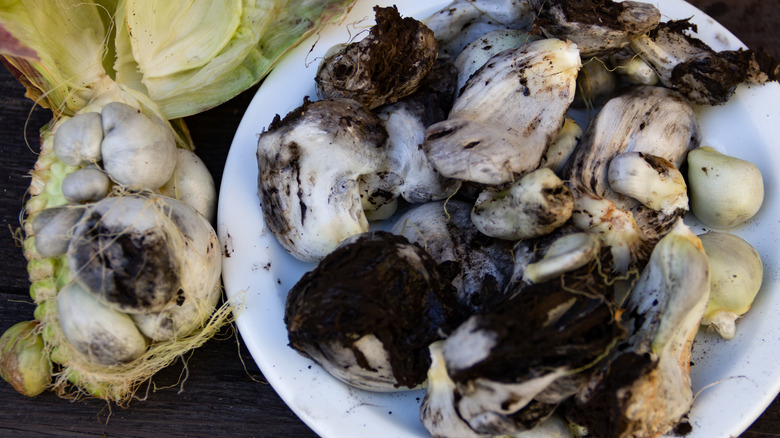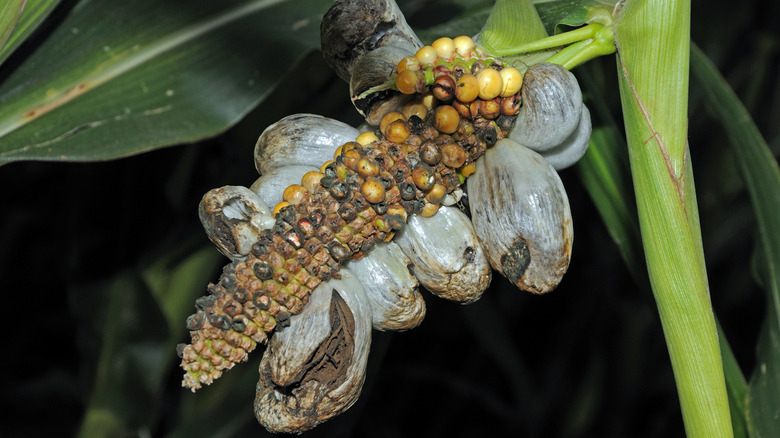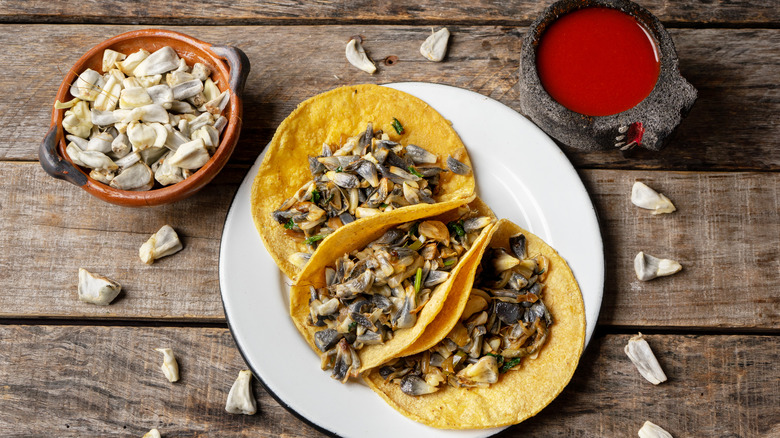What You Should Know Before Cooking With Canned Huitlacoche
In many cuisines, significant food items are born out of controlled "spoilage." Think of slabs of tempeh (legumes inoculated with fungal spores), loaves of sourdough bread (bread dough fermented with lactic acid bacteria and yeast), and the origins of numerous alcoholic drinks. Sometimes this "spoilage" happens even earlier, before the harvest of a plant. An example of this is huitlacoche, a mushroom-like fungus that infects the ears of corn as they develop, resulting in overgrown kernels that turn dark blue. While not a desirable result for many U.S. farmers who regard it as a blight, huitlacoche is a delicacy in Mexico and is served in many different dishes all over the country.
Fresh huitlacoche is usually available during Mexico's rainy season (early summer through late fall). Unfortunately, the further one gets from Mexico, the likelihood of procuring fresh huitlacoche lessens, which means that in many places only canned or jarred versions are available. While some say these canned versions taste far removed from the fresh ones, it may be all that's available and, therefore, will have to suffice.
Aside from it possibly being more expensive, canned or jarred versions may be seasoned before packing, and include uninfected kernels (i.e. not huitlacoche) that get harvested from the cob along with the good stuff. So as long as you keep that in mind, you'll be able to enjoy this Mexican delicacy year-round.
What does huitlacoche taste like?
What does huitlacoche taste like? Being the result of fungus, it has definitely been described as being akin to mushrooms, i.e. earthy and nutty. It also has a sweetness to it, carried over by its original form of corn. Some folks even call it truffle-like, though with a smokiness that makes huitlacoche a unique flavor on its own.
The ideal texture of the kernels for huitlacoche enthusiasts is plump, a touch spongy, and yielding to the bite. If the kernels are underripe and hard, the taste can be off-puttingly bitter. On the other end of the spectrum, overripe kernels become rather fragile. And despite the cons of canned huitlacoche, it is canned at its peak, much like other canned produce — a big point in its favor.
This acquired flavor is sought after by many restaurant chefs and home cooks, and as consumer tastes evolve over the years, more and more US farmers are intentionally inoculating their corn crops with ustilago maydis, the fungus that turns kernels into huitlacoche. This prized corn fungus provides a supplementary income for said farmers as it is worth more than corn by weight, about $15 to $20 per pound.
How do you cook with canned huitlacoche?
So how does one cook with canned huitlacoche? Before you begin, as with other canned produce, read the label. Common ingredients packed with huitlacoche are vegetable oil, onions, and salt. Taste a piece first to know what you are working with. You might not need to add as much salt, or you may want to drain any excess oil before combining the huitlacoche with other ingredients. Once you have a good sense of the added ingredients, proceed with your recipe of choice.
Traditionally, huitlacoche is used as a filling for tamales, or stuffed into quesadillas or tacos with fresh Mexican cheese, like Oaxaca cheese. It can also be incorporated into sauces, soups, and stews. Beyond Mexican cuisine, you can cook huitlacoche as you would mushrooms, as it is technically a fungus. Fold it into omelets for a substantial breakfast, or even substitute chopped meat in your stir-fries with a portion of huitlacoche. James Beard Award-winning Mexican chef Pati Jinich is a fan of stuffing delicate crepes with a mixture of huitlacoche, corn, and squash blossoms, a dish that is traditionally offered to guests at weddings around Mexico City.


